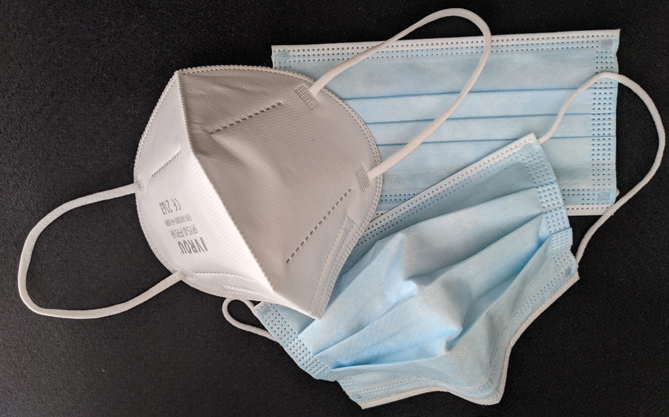The advent of the ongoing pandemic has introduced significant changes to our daily lives. One of them is the use of protective face masks which, aside from other inconveniences (in my case, a pesky dry eye), muffle speech, which of course translates to reduced intelligibility both in normal person-to-person conversations as well as for sound reinforcement (not to mention broadcast and recording).
Though it’s immediately obvious that masks deaden sound coming from our mouths, I wanted to objectively evaluate the effect. Normally I would use a lab-type analyzer to measure the frequency dependent attenuation, but in this case, I decided to test-drive John Mulcahy’s REW (Room EQ Wizard), a free (donation-ware) measurement software with sweep capabilities.
Determining The Criteria
To gather the data, and since I did not have access to an artificial head with a “mouth” loudspeaker, and rather than simply placing masks in front of a measurement microphone, I would employ a smallish loudspeaker (sound bar-type) with a full-range driver that would be fed frequency sweeps while covered with different types of masks. This way, I could measure both the impact of various mask materials on the signal as well as the effects of the differing shapes of the masks.
A year ago, masks were hard to come by outside of the medical profession, with people resorting to making their own at home. These days there are plenty of commercially available masks of differing types and filtering capabilities. I decided to test two common types: a standard domestic-pleated surgical-style model and a “duck-beak” type disposable model.
Specifically, the surgical-style mask has three layers (one hydrophobic polypropylene on the outside and another on the inside as well as polyester layer on the inside), as specified by our local Spanish Covid-19 standard and also complying with the T/GDBX 025-2020 standard from the Guangdong province of China. It’s stated to offer 99 percent filtration as tested by a consumer organization.
The duck-beak type, classified as offering FFP2-level protection, have five layers – one hydrophobic on the outside followed by two polypropylene, then cotton, and finally, a hypoallergenic layer on the inside. It is stated to provide a minimum of 94 percent filtration complying to European Union standard EN149, very similar to a U.S. N95 mask and other masks of its ilk used around the globe. The audible impact of this mask is pretty extreme compared to the other one.
First, I measured the loudspeaker’s unmasked response as the basis of comparison, and then simply ran frequency sweeps through the loudspeaker covered by each type of mask and recorded the data. With the surgical-style model, I measured once with the mask flat against the loudspeaker and then another with it hollowed out to better resemble the shape it adopts when worn. This was followed by a measurement of the duck-beak type.
The relative 1/3rd-octave smoothed frequency responses are shown in Figure 1 – light blue shows the flat surgical, dark blue depicts the shaped surgical, and black corresponds to duck beak. Although one might expect a gradual high-frequency roll-off, the effect is more like a 4 dB down step for surgical and an 8 dB down step for duck beak. A small amount of acoustical gain (i.e., level over 0 dB) can also be observed at some frequencies).

Further, as one would likely expect, the flat surgical mask shows more HF attenuation as compared to the partially unfolded (hollowed out) one, as there is more material per surface area.
Taking It Further
The shape of the attenuation caused by the masks, as shown in the frequency response measurements, can help in determining “quick and dirty” correction via shelving (Baxandall) equalization that’s commonly available on pretty much any mixer. While one could use the measurements to determine a larger set of EQ filters to more comprehensively counteract the effect of the masks (and the microphone protection, if used), there are many possible types of masks and fittings, so I concentrated on simpler EQ solutions.
I used REW’s equalization functionalities (there’s a choice of generic EQ or selection a specific device from the built-in library) to test a mixer-like shelving filter (with a fixed 6 dB/octave slope), as well as a more parametric version with selectable corner frequency and slope (a 12 dB/octave slope is a better fit for the step shape of the masks’ attenuation).
Figure 2 shows the relative frequency response of the duck beak mask (black trace) as well as corrected responses with a parametric shelving filter (12 dB/octave slope and 3.5 kHz corner frequency) and a mixer-style shelving filter (which I checked that matched the one in a basic analog mixer I have in my office, except for a bit of overshoot).

For the former (in dark grey) I used a gain of 8 dB as a compromise solution for HF lift and overall flatness; for the latter (light grey trace), the shallow slope means a bit of a peak develops at around 1.4 kHz, so I eased the gain down to 7 dB. The traces of the two shelving filters applied are shown in green.
The mixer-style shelving EQ does not work as well with the surgical mask. Figure 3 shows the relative frequency response of this mask (dark blue) as well as corrected responses with a parametric shelving filter (12 dB/octave slope and 4.5 kHz corner frequency) and, again, a mixer-style shelving filter. For the former (in darker blue) I used a 4 dB gain; for the latter (lightest blue trace), I used 3 dB gain so as not to emphasize the 2 kHz plateau. The traces of the two shelving filters used are shown in green. The partially unfolded version of the mask was used for the EQ emulation, because it’s closer to real life.

The conclusion is that the attenuation of face masks can be quite severe, but it can also be reasonably corrected using just shelving EQ, ideally parametric with 12 dB/octave slope and selectable corner frequency, or else utilizing a mixer’s HF control.




















